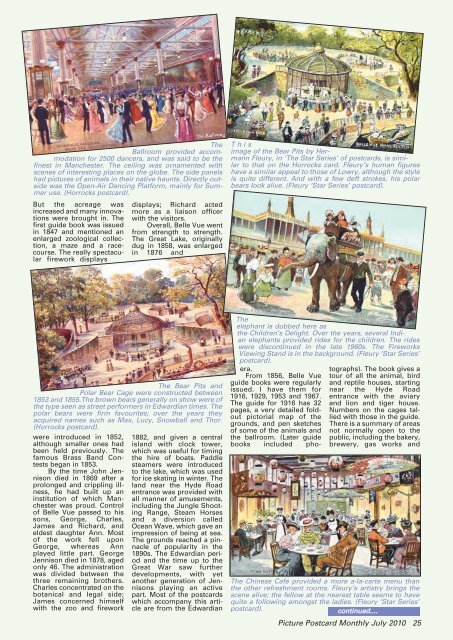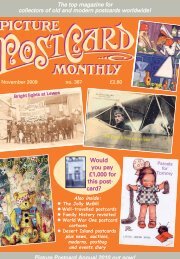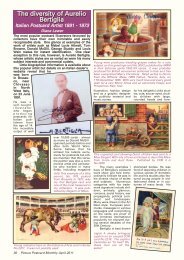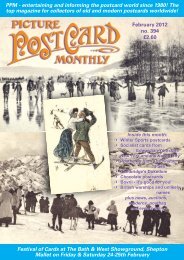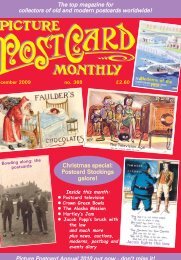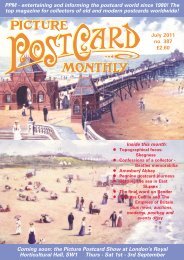PPM revisits Manchester's Belle Vue amusement park - Picture ...
PPM revisits Manchester's Belle Vue amusement park - Picture ...
PPM revisits Manchester's Belle Vue amusement park - Picture ...
You also want an ePaper? Increase the reach of your titles
YUMPU automatically turns print PDFs into web optimized ePapers that Google loves.
The<br />
Ballroom provided accommodation<br />
for 2500 dancers, and was said to be the<br />
finest in Manchester. The ceiling was ornamented with<br />
scenes of interesting places on the globe. The side panels<br />
had pictures of animals in their native haunts. Directly outside<br />
was the Open-Air Dancing Platform, mainly for Summer<br />
use. (Horrocks postcard).<br />
But the acreage was<br />
increased and many innovations<br />
were brought in. The<br />
first guide book was issued<br />
in 1847 and mentioned an<br />
enlarged zoological collection,<br />
a maze and a racecourse.<br />
The really spectacular<br />
firework displays<br />
displays; Richard acted<br />
more as a liaison officer<br />
with the visitors.<br />
Overall, <strong>Belle</strong> <strong>Vue</strong> went<br />
from strength to strength.<br />
The Great Lake, originally<br />
dug in 1858, was enlarged<br />
in 1876 and<br />
This<br />
image of the Bear Pits by Hermann<br />
Fleury, in ‘The Star Series’ of postcards, is similar<br />
to that on the Horrocks card. Fleury’s human figures<br />
have a similar appeal to those of Lowry, although the style<br />
is quite different. And with a few deft strokes, his polar<br />
bears look alive. (Fleury ‘Star Series’ postcard).<br />
The Bear Pits and<br />
Polar Bear Cage were constructed between<br />
1853 and 1855.The brown bears generally on show were of<br />
the type seen as street performers in Edwardian times. The<br />
polar bears were firm favourites; over the years they<br />
acquired names such as Max, Lucy, Snowball and Thor.<br />
(Horrocks postcard).<br />
were introduced in 1852,<br />
although smaller ones had<br />
been held previously. The<br />
famous Brass Band Contests<br />
began in 1853.<br />
By the time John Jennison<br />
died in 1869 after a<br />
prolonged and crippling illness,<br />
he had built up an<br />
institution of which Manchester<br />
was proud. Control<br />
of <strong>Belle</strong> <strong>Vue</strong> passed to his<br />
sons, George, Charles,<br />
James and Richard, and<br />
eldest daughter Ann. Most<br />
of the work fell upon<br />
George, whereas Ann<br />
played little part. George<br />
Jennison died in 1878, aged<br />
only 46. The administration<br />
was divided between the<br />
three remaining brothers.<br />
Charles concentrated on the<br />
botanical and legal side;<br />
James concerned himself<br />
with the zoo and firework<br />
1882, and given a central<br />
island with clock tower,<br />
which was useful for timing<br />
the hire of boats. Paddle<br />
steamers were introduced<br />
to the lake, which was used<br />
for ice skating in winter. The<br />
land near the Hyde Road<br />
entrance was provided with<br />
all manner of <strong>amusement</strong>s,<br />
including the Jungle Shooting<br />
Range, Steam Horses<br />
and a diversion called<br />
Ocean Wave, which gave an<br />
impression of being at sea.<br />
The grounds reached a pinnacle<br />
of popularity in the<br />
1890s. The Edwardian period<br />
and the time up to the<br />
Great War saw further<br />
developments, with yet<br />
another generation of Jennisons<br />
playing an active<br />
part. Most of the postcards<br />
which accompany this article<br />
are from the Edwardian<br />
The<br />
elephant is dubbed here as<br />
the Children’s Delight. Over the years, several Indian<br />
elephants provided rides for the children. The rides<br />
were discontinued in the late 1960s. The Fireworks<br />
Viewing Stand is in the background. (Fleury ‘Star Series’<br />
postcard).<br />
era.<br />
From 1856, <strong>Belle</strong> <strong>Vue</strong><br />
guide books were regularly<br />
issued. I have them for<br />
1916, 1929, 1953 and 1967.<br />
The guide for 1916 has 32<br />
pages, a very detailed foldout<br />
pictorial map of the<br />
grounds, and pen sketches<br />
of some of the animals and<br />
the ballroom. (Later guide<br />
books included photographs).<br />
The book gives a<br />
tour of all the animal, bird<br />
and reptile houses, starting<br />
near the Hyde Road<br />
entrance with the aviary<br />
and lion and tiger house.<br />
Numbers on the cages tallied<br />
with those in the guide.<br />
There is a summary of areas<br />
not normally open to the<br />
public, including the bakery,<br />
brewery, gas works and<br />
The Chinese Café provided a more a-la-carte menu than<br />
the other refreshment rooms. Fleury’s artistry brings the<br />
scene alive; the fellow at the nearest table seems to have<br />
quite a following amongst the ladies. (Fleury ‘Star Series’<br />
postcard).<br />
continued....<br />
<strong>Picture</strong> Postcard Monthly July 2010 25


